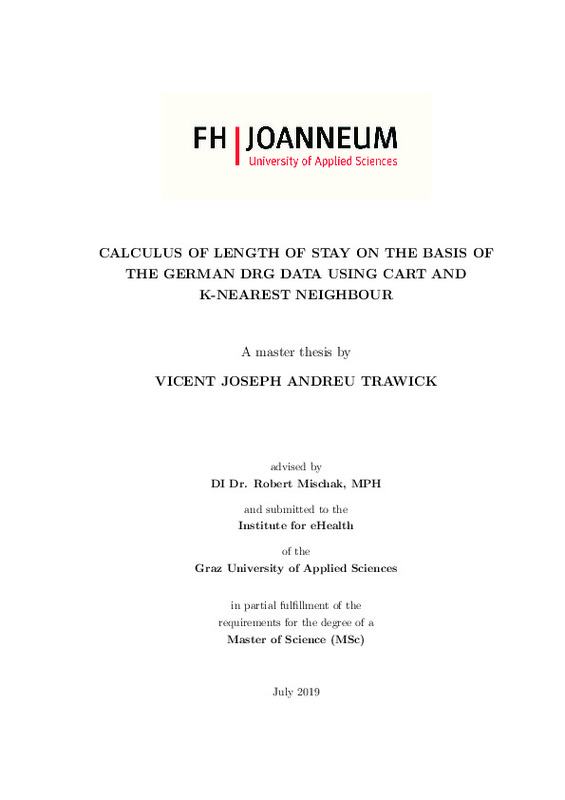JavaScript is disabled for your browser. Some features of this site may not work without it.
Buscar en RiuNet
Listar
Mi cuenta
Estadísticas
Ayuda RiuNet
Admin. UPV
Cálculo de la duración de la estancia a partir de los datos de DRG alemanes utilizando CART y k-nearest neighbour
Mostrar el registro sencillo del ítem
Ficheros en el ítem
| dc.contributor.advisor | Moratal Pérez, David
|
es_ES |
| dc.contributor.author | Andreu Trawick, Vicent Joseph
|
es_ES |
| dc.date.accessioned | 2020-05-14T14:47:51Z | |
| dc.date.available | 2020-05-14T14:47:51Z | |
| dc.date.created | 2019-09-09 | |
| dc.date.issued | 2020-05-14 | es_ES |
| dc.identifier.uri | http://hdl.handle.net/10251/143278 | |
| dc.description.abstract | [ES] La duración de la estancia (LOS) se define como la duración de un único episodio de hospitalización. Se utiliza como un indicador que describe cuánto de eficiente el hospital utiliza sus recursos. La duración de la estancia también está vinculado a un aumento de infecciones adquiridas en el hospital y a un incremento de los efectos secundarios causadas por la medicación. En esta tesis se utilizarán modelos de inteligencia artificial para predecir la duración de estancia a partir de los datos presentes de registros médicos electrónicos de un hospital de Alemania. El primer objetivo es clasificar entre un paciente que se quedará en el hospital durante un largo plazo o durante un corto plazo. Los clasificadores utilizados serán el árbol de clasificación y k-nearest neighbour. Posteriormente, se entrenará un modelo de árbol de regresión para predecir la duración exacta de la estancia en días de los pacientes. | es_ES |
| dc.description.abstract | [EN] The length of stay (LOS) is defined as the duration of a single episode of hospitalization. It is used as an indicator of how efficient a hospital utilizes its resources. LOS is also linked to hospital related side effects. A higher stay tends to increase both the infections acquired in the hospital and the medication side effects. In this thesis, artificial intelligence models will be used to predict the duration of the length of stay based on the data extracted from electronic health records from a hospital in Germany. The first objective is to classify between a long-term patient and a short-term patient. The classifiers used will be the classification tree and the k-nearest neighbour. Afterwards, a regression tree model will be trained to predict the exact length of stay in days of the patients. | es_ES |
| dc.language | Inglés | es_ES |
| dc.publisher | Universitat Politècnica de València | es_ES |
| dc.rights | Reconocimiento - No comercial (by-nc) | es_ES |
| dc.subject | Duración de la estancia (LOS) | es_ES |
| dc.subject | ICD code | es_ES |
| dc.subject | CART | es_ES |
| dc.subject | K-nearest neighbour | es_ES |
| dc.subject | DRG | es_ES |
| dc.subject | Lenght of stay (LOS) | es_ES |
| dc.subject.classification | TECNOLOGIA ELECTRONICA | es_ES |
| dc.subject.other | Máster Universitario en Ingeniería Biomédica-Màster Universitari en Enginyeria Biomèdica | es_ES |
| dc.title | Cálculo de la duración de la estancia a partir de los datos de DRG alemanes utilizando CART y k-nearest neighbour | es_ES |
| dc.type | Tesis de máster | es_ES |
| dc.rights.accessRights | Abierto | es_ES |
| dc.contributor.affiliation | Universitat Politècnica de València. Departamento de Ingeniería Electrónica - Departament d'Enginyeria Electrònica | es_ES |
| dc.contributor.affiliation | Universitat Politècnica de València. Escuela Técnica Superior de Ingenieros Industriales - Escola Tècnica Superior d'Enginyers Industrials | es_ES |
| dc.description.bibliographicCitation | Andreu Trawick, VJ. (2019). Cálculo de la duración de la estancia a partir de los datos de DRG alemanes utilizando CART y k-nearest neighbour. http://hdl.handle.net/10251/143278 | es_ES |
| dc.description.accrualMethod | TFGM | es_ES |
| dc.relation.pasarela | TFGM\113678 | es_ES |
Este ítem aparece en la(s) siguiente(s) colección(ones)
-
ETSII - Trabajos académicos [10404]
Escuela Técnica Superior de Ingenieros Industriales






